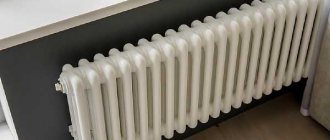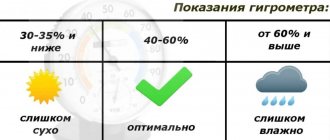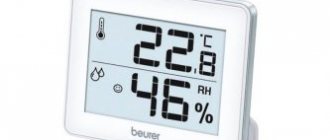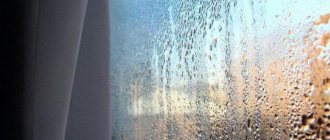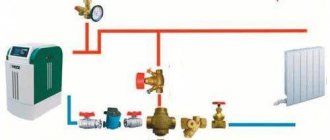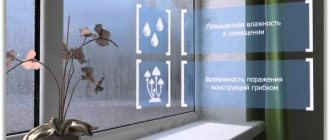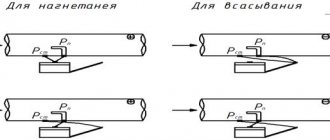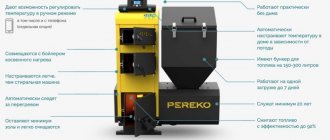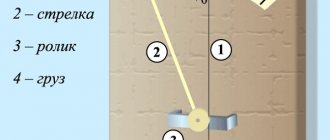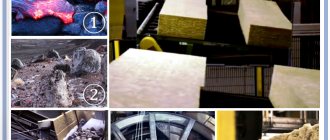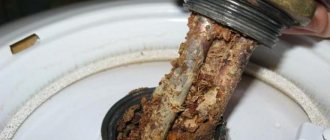Types of hygrometers
Hygrometers are divided into a large number of types according to their structure, operating principle and functionality.
| Type of hygrometer | Photo | Description |
| Psychrometric | Relative humidity is determined by the temperature difference between dry and wet bulb thermometers, by comparing the obtained data with a table | |
| Weight | It consists of tubes with a hygroscopic composition and a pump for pumping air. Absolute humidity is determined by the volume of air and the weight of the structure before and after the procedure | |
| Film | A dial-type device with a sensor in the form of an organic film that changes its length when moistened | |
| Hairline | The principle of operation is similar to the film unit, but the sensor here is fat-free hair | |
| Electrolytic | The basis of the design is a plate of glass, polystyrene or other electrical insulating material, coated with an electrolyte layer that changes resistance when wet | |
| Ceramic | The sensor in this device is a hard, porous ceramic mass, which changes resistance under the influence of humidity | |
| Condensation | Allows you to determine humidity using a table and a specific dew point. The design consists of a mirror, a thermometer and a cooling element | |
| Optoelectronic | Repeats the mechanism of action of a condensation unit with subsequent heating of the mirror, which allows you to obtain more accurate results | |
| Capacitive | Consists of an oxide capacitor, the capacity of which depends on the moisture content in the air | |
| Resistive | The principle of operation is the effect of moisture on the resistance of salts and polymers |
Moisture meters can also be grouped by data output option:
- analog - a standard device with a dial and a moving arrow;
- digital - a multi-device that displays numerical data on an LCD monitor.
The units also differ in design:
- contact - it is used to take measurements in various materials (wood, concrete, etc.). Induction types are attached to the surface, and needle types are immersed in the thickness of the product;
Contact conductometric electric moisture meter - non-contact – used to record the degree of humidification of gaseous mixtures, including air.
Non-contact digital moisture meter
Relative humidity (RH)
As mentioned above, the amount of water that air is able to absorb and retain depends on the air temperature. That is, each specific air temperature corresponds to a certain maximum amount of water vapor that can be present in it. This quantity is called saturated vapor density; air is accordingly called saturated.
Relative air humidity is defined as the ratio of absolute humidity to its maximum possible value at the same temperature - the limiting value of absolute humidity (dew point). The lower the relative humidity, the drier the air.
Relative humidity formula - how air RH is calculated
Relative air humidity is calculated using the following formula, and is measured as a percentage:
RH = AH / maxAH x100%
Where, RH is relative air humidity, AH is absolute air humidity, maxAH is the maximum absolute air humidity for a certain temperature (dew point).
TOP 13 best hygrometers
| Photo | Name | Rating | Price | |||
| The best contact digital thermohygrometers | ||||||
| #1 | ADA instruments ZHT 70 | ⭐ 100 / 100 | Find out the price | |||
| #2 | CEM DT-125H | ⭐ 99 / 100 | Find out the price | |||
| #3 | CEM DT-129 | ⭐ 98 / 100 | Find out the price | |||
| #4 | MEGEON 20610 | ⭐ 97 / 100 | Find out the price | |||
| #5 | Testo 606-1 | ⭐ 96 / 100 | Find out the price | |||
| #6 | CEM DT-125G | ⭐ 95 / 100 | Find out the price | |||
| The best non-contact hygrometers moisture meters | ||||||
| #1 | ADA instruments ZHT 100-70 | ⭐ 100 / 100 | Find out the price | |||
| #2 | ADA instruments AeroPipe | ⭐ 99 / 100 | Find out the price | |||
| #3 | Xiaomi Mijia Hygrometer Bluetooth | ⭐ 98 / 100 | Find out the price | |||
| #4 | Anymetre TH101B | ⭐ 97 / 100 | Find out the price | |||
| #5 | Xiaomi MiJia Miaomiaoce E-Ink | ⭐ 96 / 100 | Find out the price | |||
| #6 | CEM DT-321 | ⭐ 95 / 100 | Find out the price | |||
| #7 | CEM DT-625 | ⭐ 94 / 100 | Find out the price | |||
Which hygrometer would you choose or recommend?
Take the survey
Tips: how to measure room humidity
There are several ways to determine the humidity level in a room:
- using a hygrometer. This is the easiest and fastest option, characterized by highly accurate results;
Indoor hygrometer - using a glass of water. Pour cold liquid into a glass container and cool it to 3-5 degrees. The glass is placed in the room, at a considerable distance from the batteries, and they wait for the result. If the fogged walls dry out after 10 minutes, then the humidity in the room is quite low. Normally, condensation will remain on the glass for a long time without evaporating;
Measuring indoor humidity using a glass of water - using a thermometer. A conventional mercury device measures air temperature. The thermometer head is wrapped with dampened cotton wool and left for 10 minutes. The data obtained is subtracted from the readings of the dry device. The final number is checked against the Assmann table and the humidity level in the room is determined.
Measuring indoor humidity using a thermometer
You should not trust traditional methods of measuring humidity too much, since they have low accuracy and only serve as a determining factor in the need to purchase specialized equipment.
Video - How to determine air humidity at home
Absolute humidity (AH)
Humid air is produced when moisture in the form of water vapor enters dry air.
Absolute air humidity (AH) determines the amount or concentration of water per m3, that is, it determines the actual mass of water in one cubic meter of air.
For example, at a temperature of 30 °C, absolute explosives can range from 0 to 30 grams per cubic meter.
Absolute humidity formula - how air AH is calculated
As you might have guessed, absolute explosive is calculated using the following formula:
AH = M/V
Where, AH is absolute humidity, M is the mass of water vapor, V is the volume of air.
Units of measurement of absolute humidity: SI - kg/m³; GHS - g/cm³.
Where, SI is the international system of measurements, and GHS is the absolute physical system of units (centimeter-gram-second), which was actively used before the approval of SI.
The amount of water in a volume of air has its own limiting values. When the limit values are reached, saturation occurs and the water vapor turns into the liquid state of water - the water vapor condenses into small droplets of water. We can observe this process in nature, for example, in the form of fog or dew on the surface of any bodies.
The moment of condensation, after reaching the limit values, is called the dew point. The limit values for the mass of water in the air depend on the ambient temperature. The lower the temperature of the air, the less water it can hold before saturation or dew point.
Recommendations for selection
- For domestic use, a budget mechanical version of a hygrometer is suitable, but for industrial purposes it is preferable to opt for electronic models with high accuracy of readings;
- It is also important to consider the purpose of the device and the frequency of its operation. In construction, you will need a moisture meter designed to work with a variety of materials - wood, cement mixtures, sand;
- conditions of use are an equally significant characteristic. Hygrometer models vary in the range of detected humidity and temperature values;
- an incorrectly selected device can produce data with a significant error when it goes beyond the maximum and minimum values;
- depending on the specific use, a unit operating at very low or high temperatures may be useful;
- mobile moisture meters are useful for one-time periodic measurements, and stationary models are convenient for larger-scale tasks with storing and processing the results;
- For ease of perception, the display of information on the display should also be taken into account. Large and contrasting numbers will be easier to read, and the backlight will allow you to work with the device in low light;
- mobile devices should fit comfortably in the hand, be light and compact;
- Hygrometers are widely used in various fields, they are used in production, they help control humidity and a comfortable microclimate in the apartment, and also ensure stable operation of equipment.
Video - Review of electronic thermometers with humidity sensor
Other options for measuring indoor air humidity
Of course, not everyone wants to constantly tinker with a calculation table, and in this case, buying a psychrometric hygrometer is not the best option. Electrical devices that combine several functions at once, for example, a clock, thermometer, barometer, hygrometer, are very popular today.
Another popular combination is a humidifier with a hygrometer. Buying such a device is not difficult, but its use also has some subtleties. The main problem is that air humidity is measured in close proximity to the moisture source, which means it is quite difficult to consider this data reliable.
It goes without saying that homemade appliances are also used in everyday life. So, making a room thermometer-hygrometer with your own hands is quite simple. But it is worth considering that the error that you will encounter while using it will undoubtedly be greater than in the case of using an electronic or mechanical hygrometer.
A hygrometer in modern design will decorate your interior
Voting for the best hygrometer
Which hygrometer would you choose or recommend?
ADA instruments ZHT 70
0% ( 0 )
CEM DT-125H
0% ( 0 )
CEM DT-129
0% ( 0 )
MEGEON 20610
0% ( 0 )
Testo 606-1
0% ( 0 )
CEM DT-125G
0% ( 0 )
ADA instruments ZHT 100-70
0% ( 0 )
ADA instruments AeroPipe
0% ( 0 )
Xiaomi Mijia Hygrometer Bluetooth
0% ( 0 )
Anymetre TH101B
0% ( 0 )
Xiaomi MiJia Miaomiaoce E-Ink
0% ( 0 )
CEM DT-321
0% ( 0 )
